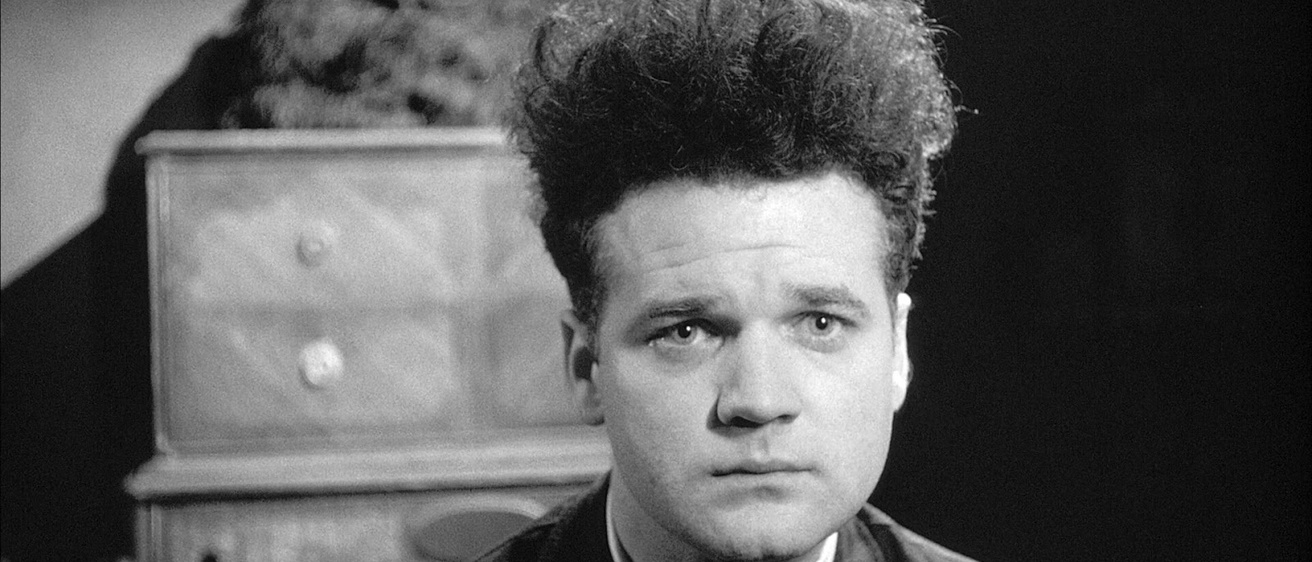By John Howard
Earlier this month, The Bijou Film Board put on a showing of David Lynch’s enigmatic classic Eraserhead (1977) to a packed house, and with its 11 P.M. showtime the film felt right at home with the original midnight movie screenings that put it on the map. The film follows Henry Spencer (Jack Nance), a hapless and naive man who is coerced into marrying his girlfriend (Charlotte Stewart) to take care of a grotesque, mutant-like baby. A considerable amount of David Lynch’s films closely follow dream logic, and Eraserhead is the first and archetypal example of Lynch’s somnial obsessions. The film however, feels much nearer to a fever dream or a nightmare than to the dreams of a sound mind.
The surrealist qualities of Eraserhead rely on grotesque and textured visuals.We are given Freudian images of massive sperm cell-like creatures falling in dark pools of water, and we’re given a glimpse into another planet where a coarse and cratered Jack Fisk is pulling the strings of the show. Miniature man-made chickens come alive and spew bloody humors from the jab of a fork, and convulsive revulsions ensue from the characters in response. Henry’s hallucinations are ripe with sexual overtones of a meteor-faced woman (Laurel Near) shuffling across a dingy stage within a radiator, giddily stomping on the pus-filled sperm creatures from earlier in the film. Another sequence finds Henry and his neighbor (Judith Roberts) descending into a murky pool within Henry’s bed, drowning themselves in the caresses of sexual oblivion. At the center of the morbid menagerie is of course the baby, near-impossible to pin down as any living, terrestrial creature. Despite the baby’s otherworldliness, it manages to be incredibly convincing, with its head moving just as any other infant’s would and its eyes and mouth moving similarly to a familiar mammal. The baby acts as the source of sensory overload during the last ten minutes of the film, as it erupts with a disgusting array of humors after being cut open by Henry. It’s enlarged head hops around Henry’s room taunting him in a death dance while Henry cowers in the corner as his entire world crumbles.
Despite plentifully putrid images, Eraserhead would not nearly achieve its uncanny and discomforting feel without its soundtrack. The harsh and industrial soundscape comes to life through galvanized and gripping drones that hold the entire audience captive in a sonorous trance. Low-pitched buzzing hums keep the tension high, and squishing sounds that accompany the more grotesque images on the screen had audience members at the screening cringing. The radiator sequences are particularly memorable, with a ghostly, detached organ playing while The Lady in the Radiator meekly shuffles her way across the sperm-littered stage and gleefully stares back at the audience, as if reveling in their disbelief. An original track with lyrics penned by David Lynch is at the center of the soundscape. The Lady in the Radiator’s vocals mesh eerily with Fats Waller’s organ, creating a hypnagogic effect; “In heaven, everything is fine,” she sings, and with what Henry has to face in his everyday life, it’s no wonder he escapes to the heaven he finds in the radiator behind the whirrs and whistles of the pipes and coils.
Eraserhead is a sensory circus of a film and Lynch is the ringleader; freak show horrors, black comedy routines, and disturbing musical numbers are all part of the show in Lynch’s dream diorama. The score to this circus is one that is uniquely tangible in its textural presentation, and it has an animalistic and volatile nature about it; it is unsettlingly serene, but also has a tendency to instinctively snap and disorient viewers. Despite the forty years since its initial release, Eraserhead has proven that it lies in a time and world of its own, immune to the tasking trials of aging and technological advancement that puts many other films of its era out of date.
